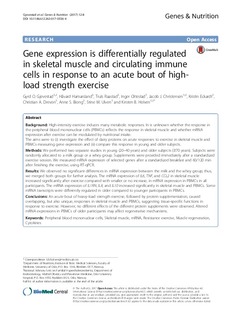| dc.description.abstract | Background: High-intensity exercise induces many metabolic responses. In is unknown whether the response in the peripheral blood mononuclear cells (PBMCs) reflects the response in skeletal muscle and whether mRNA expression after exercise can be modulated by nutritional intake. The aims were to (i) investigate the effect of dairy proteins on acute responses to exercise in skeletal muscle and PBMCs measuring gene expression and (ii) compare this response in young and older subjects. Methods: We performed two separate studies in young (20–40 years) and older subjects (≥70 years). Subjects were randomly allocated to a milk group or a whey group. Supplements were provided immediately after a standardized exercise session. We measured mRNA expression of selected genes after a standardized breakfast and 60/120 min after finishing the exercise, using RT-qPCR. Results: We observed no significant differences in mRNA expression between the milk and the whey group; thus, we merged both groups for further analysis. The mRNA expression of IL6, TNF, and CCL2 in skeletal muscle increased significantly after exercise compared with smaller or no increase, in mRNA expression in PBMCs in all participants. The mRNA expression of IL1RN, IL8, and IL10 increased significantly in skeletal muscle and PBMCs. Some mRNA transcripts were differently regulated in older compared to younger participants in PBMCs. Conclusions: An acute bout of heavy-load strength exercise, followed by protein supplementation, caused overlapping, but also unique, responses in skeletal muscle and PBMCs, suggesting tissue-specific functions in response to exercise. However, no different effects of the different protein supplements were observed. Altered mRNA expressions in PBMCs of older participants may affect regenerative mechanisms. | nb_NO |
